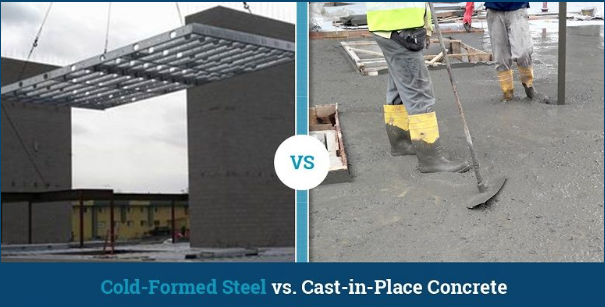How Cold-Formed Steel Compares to Cast-in-Place Concrete in 4 Key Areas

How does cold-formed steel (CFS) compare to cast-in-place concrete when framing a building? Neither material has the monopoly on benefits. The “best” material depends on the project.
For example, the stiffness and heavy weight of concrete provides resistance to deflection and overturning due to wind loads, which are often important factors in the design of slender, high-rise buildings. On the other hand, CFS has design and construction advantages, and it is cost-effective in low and mid-rise construction.
Let’s take a further look. Here’s how CFS and cast-in-place concrete compare in four key areas.
1. Strength-to-weight ratio
According to the Steel Framing Alliance (SFA), cold-formed steel has the highest strength-to-weight ratio of any construction material.
Foundation savings
Due to its high strength and light weight, less weight of CFS material is required to carry the same structural load as concrete. Here’s how it works:
- CFS framing reduces a building superstructure’s weight. In fact, the weight of a CFS framing system can be up to 50 percent less than a comparable concrete framing system.
- The CFS framing system’s lighter weight (i.e., dead load) calls for smaller foundations with less concrete to support the structure. That means the foundation for a CFS structure can cost considerably less than a comparable concrete
Lightweight flooring systems
CFS’s high strength-to-weight ratio also benefits the design of flooring systems:
- A designer might choose a flooring system comprised of cold-formed steel composite deck with structural concrete fill. This type of system would provide a solid concrete deck option. However, because of the relatively heavy weight of the concrete, such systems are often limited to about eight stories when used in combination with a CFS load-bearing wall system.
- As an alternative, a lower profile cold-formed steel deck with a self-leveling gypsum-based product, one that sets up to 3,500 psi, provides a solid concrete feel, and keeps the flooring system lightweight, allowing CFS load bearing wall systems to be used for taller buildings.
2. Off-site construction
Unlike cast-in-place concrete, CFS components can be assembled off-site. This is ideal for mid-rise construction, which tends to involve designs with identical, repetitive sections.
Cuts man-hours, waste
Off-site construction or prefabrication of CFS walls, subfloor systems, and trusses:
- Reduces the labor cost required to assemble the structural framing system
- Reduces construction waste
- Minimizes costly weather delays
- Ensures greater quality control
- Reduces builder’s risk
- Increases speed of construction
3. Project timelines
Benefits to other trades
CFS structures go up faster than comparable cast-in-place concrete-framed structures, allowing follow-on trades to get to work sooner.
Benefits to the community
In urban areas, the speed of CFS framing reduces disruption to nearby buildings, lowers traffic congestion, and lowers the impact on the neighborhood.
Benefits to owners
Time savings can reduce the owner’s requirements for working capital, lower finance charges, pare site supervision, and improve cash flow.
4. Cost of construction
Ultimately, the benefits of CFS mentioned above can lead to lower overall cost of construction. For example, by using CFS framing, a developer was able to shave six weeks off the construction of a five-story apartment building in Brantford, Ontario versus using poured concrete or masonry. Time-related savings can amount to between 3 and 5 percent of the overall project value.
In this case, the timeline allowed the owner to move clients in sooner and earn addition revenue — in this case, an extra $100,000 in rent.
Additional cost advantages
By allowing shorter construction timeframes versus cast-in-place concrete, CFS projects tend to have:
- Lower project interim financing costs
- Lower crane rental costs
- Less scaffolding rental durations
Learn more about building a cost-effective mid-rise building by downloading the eBook, “Building Within Budget: Ideas for Shaving Months and Dollars Off Your Next Construction Project.”
If you have additional questions about the design, engineering, or construction of a CFS-framed project, the BuildSteel team of experts offer complimentary project assistance. Request assistance here.